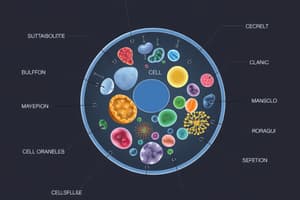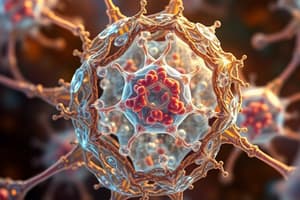Podcast
Questions and Answers
Which of the following is NOT a primary function of cells?
Which of the following is NOT a primary function of cells?
- Metabolism
- Creating new organisms (correct)
- Maintaining homeostasis
- Producing hormones
What is the significance of the cell theory, as proposed by Schleiden and Schwann?
What is the significance of the cell theory, as proposed by Schleiden and Schwann?
- It proved that all living organisms are made up of cells. (correct)
- It established the role of the nucleus in cell function.
- It demonstrated the existence of cells for the first time.
- It explained the process of cell division.
Based on the text, which of these is NOT a major component of the organizational hierarchy of life?
Based on the text, which of these is NOT a major component of the organizational hierarchy of life?
- Atoms
- Organelles
- Organisms
- Ecosystems (correct)
Why are red blood cells (RBCs) typically thin and flat in shape?
Why are red blood cells (RBCs) typically thin and flat in shape?
What is the significance of water being the most abundant compound in cells and the extracellular environment?
What is the significance of water being the most abundant compound in cells and the extracellular environment?
Which of the following is NOT a function of electrolytes?
Which of the following is NOT a function of electrolytes?
What is the primary function of structural proteins?
What is the primary function of structural proteins?
Which of these is a characteristic of lipids?
Which of these is a characteristic of lipids?
What is a common source of dehydration?
What is a common source of dehydration?
Which of the following is NOT a true statement about carbohydrates?
Which of the following is NOT a true statement about carbohydrates?
What is the main structure of the plasma membrane?
What is the main structure of the plasma membrane?
Which statement correctly describes the fluid mosaic model of the plasma membrane?
Which statement correctly describes the fluid mosaic model of the plasma membrane?
What type of molecules can pass through the plasma membrane due to its selectively permeable nature?
What type of molecules can pass through the plasma membrane due to its selectively permeable nature?
What is the process called when fluid molecules move across a membrane to equalize solute concentration?
What is the process called when fluid molecules move across a membrane to equalize solute concentration?
Which of the following is a function of the plasma membrane?
Which of the following is a function of the plasma membrane?
Which fatty acid is commonly sourced from cold-water fish and flaxseed oil?
Which fatty acid is commonly sourced from cold-water fish and flaxseed oil?
Omega-6 fatty acids are primarily derived from which type of food sources?
Omega-6 fatty acids are primarily derived from which type of food sources?
What term describes the outer layer of the plasma membrane that interacts with water?
What term describes the outer layer of the plasma membrane that interacts with water?
What is the primary function of cholesterol in the cell membrane?
What is the primary function of cholesterol in the cell membrane?
What role does the nucleolus play within the nucleus?
What role does the nucleolus play within the nucleus?
Which nutrient is essential for DNA synthesis and repair?
Which nutrient is essential for DNA synthesis and repair?
What is the function of the cytoskeleton?
What is the function of the cytoskeleton?
Which statement about mitochondria is true?
Which statement about mitochondria is true?
What is the composition of the nuclear envelope?
What is the composition of the nuclear envelope?
Which component is primarily responsible for protein synthesis in cells?
Which component is primarily responsible for protein synthesis in cells?
In which structure is the cytoplasm found?
In which structure is the cytoplasm found?
What is the primary function of Carnitine in the body?
What is the primary function of Carnitine in the body?
Where are the enzymes responsible for ATP production located within a cell?
Where are the enzymes responsible for ATP production located within a cell?
Which of the following processes is NOT carried out by the smooth endoplasmic reticulum (sER)?
Which of the following processes is NOT carried out by the smooth endoplasmic reticulum (sER)?
What is the significance of all mitochondria in an embryo being maternally inherited?
What is the significance of all mitochondria in an embryo being maternally inherited?
What is the likely cause of Leber's hereditary optic neuropathy?
What is the likely cause of Leber's hereditary optic neuropathy?
Flashcards
Cell
Cell
The basic unit of life, responsible for all bodily functions.
Anatomy
Anatomy
The study of the structure of body parts.
Cell Theory
Cell Theory
The theory stating that all living things are made up of cells, and all cells arise from pre-existing cells.
Metabolism
Metabolism
Signup and view all the flashcards
Water
Water
Signup and view all the flashcards
Dehydration
Dehydration
Signup and view all the flashcards
Electrolytes
Electrolytes
Signup and view all the flashcards
Proteins
Proteins
Signup and view all the flashcards
Carbohydrates
Carbohydrates
Signup and view all the flashcards
Lipids (Fats)
Lipids (Fats)
Signup and view all the flashcards
Plasma membrane
Plasma membrane
Signup and view all the flashcards
Lipid bi-layer
Lipid bi-layer
Signup and view all the flashcards
Trilaminar
Trilaminar
Signup and view all the flashcards
Fluid mosaic model
Fluid mosaic model
Signup and view all the flashcards
Selectively permeable barrier
Selectively permeable barrier
Signup and view all the flashcards
Diffusion
Diffusion
Signup and view all the flashcards
Osmosis
Osmosis
Signup and view all the flashcards
Omega-3 fatty acid
Omega-3 fatty acid
Signup and view all the flashcards
Cholesterol
Cholesterol
Signup and view all the flashcards
Nucleus
Nucleus
Signup and view all the flashcards
Nucleolus
Nucleolus
Signup and view all the flashcards
Nuclear Skeleton
Nuclear Skeleton
Signup and view all the flashcards
Cytoplasm
Cytoplasm
Signup and view all the flashcards
Ribosomes
Ribosomes
Signup and view all the flashcards
Cytoskeleton
Cytoskeleton
Signup and view all the flashcards
Mitochondria
Mitochondria
Signup and view all the flashcards
Mitochondrial Matrix
Mitochondrial Matrix
Signup and view all the flashcards
Carnitine
Carnitine
Signup and view all the flashcards
Heteroplasmy
Heteroplasmy
Signup and view all the flashcards
Leber's Hereditary Optic Neuropathy
Leber's Hereditary Optic Neuropathy
Signup and view all the flashcards
Endoplasmic Reticulum
Endoplasmic Reticulum
Signup and view all the flashcards
Study Notes
Human Anatomy - Cytology
- Anatomy studies the structure of body parts
- Cells are the basic units of structural organization
- Proper body function relies on cell function
- Understanding cell processes (respiration, protein synthesis, mitosis, meiosis) is key
- Diseases originate in cells
- Cells organize hierarchically: atoms → molecules → organelles → cells → tissues → organs → organ systems → organism
- Robert Hooke (17th century) first observed cells in cork
- Cells were named for monastery cubicles
- Cell theory (Schleiden & Schwann): all living things are made of cells, the cell is the basic unit of structure in all organisms
- All cells come from existing cells
Cell Chemistry
- Water is the most abundant compound in cells and the extracellular environment
- Water acts as a universal solvent
- It transports substances across membranes and within cells
- Dehydration occurs when fluid loss exceeds intake
- Electrolytes are inorganic compounds that form ions in water.
- These ions (acids, bases, salts) are important for:
- Water movement
- pH balance
- Nerve and muscle function
- Enzyme activity
- Low electrolyte levels can cause muscle cramps, heart failure, and brittle bones.
- Proteins are nitrogen-containing organic compounds.
- Proteins are formed from 20+ different amino acids.
- Proteins have structural and functional roles (support, enzymes, hormones)
- Carbohydrates have a 2:1 ratio of Hydrogen to Oxygen
- Types of carbohydrates include monosaccharides, disaccharides, and polysaccharides
- These serve as energy sources and storage molecules.
Cell Structure
- The cell's outer boundary is the plasma membrane (plasmalemma)
- It's a lipid bilayer with various proteins
- The outer layer is hydrophilic (water-loving) and the inner layer is hydrophobic (water-fearing)
- The structure is called a "fluid mosaic model" which is made up of two layers of lipid molecules
- The membrane is selectively permeable allowing some substances into cells and expelling others.
- Water moves to equalize concentration across a membrane (osmosis)
- Proteins within the membrane vary in structure and mobility, affecting its function
- Cells are constantly being assembled and disassembled
- Functions include anchoring organelles, cell communication
- Cells transport molecules across their environment
Other Cellular Structures
- Organelles: Membrane-bound structures within cells (e.g., mitochondria, ribosomes). They have specific functions.
- Mitochondria: Produce energy (ATP), found in most cells
- Endoplasmic Reticulum (ER): Involved in protein synthesis and lipid production. Rough ER is studded with ribosomes and plays a role in protein secretion, whereas Smooth ER plays a role in lipid metabolism.
- Golgi apparatus: Processes proteins and lipids, sorting them for transport.
- Ribosomes: Sites of protein synthesis
- Cilia and Flagella: Cytoplasmic projections that assist in movement. Cilia is short and Flagella is longer. (cilia move substances over the surface of cells or tissues; flagella power movement of the whole cell like sperm)
Studying That Suits You
Use AI to generate personalized quizzes and flashcards to suit your learning preferences.
Related Documents
Description
Test your understanding of cell functions, the significance of cell theory, and the components of life organization. This quiz covers essential concepts related to cell structure, proteins, lipids, and water's role in biological systems. Dive in to see how well you grasp these foundational topics in biology.




